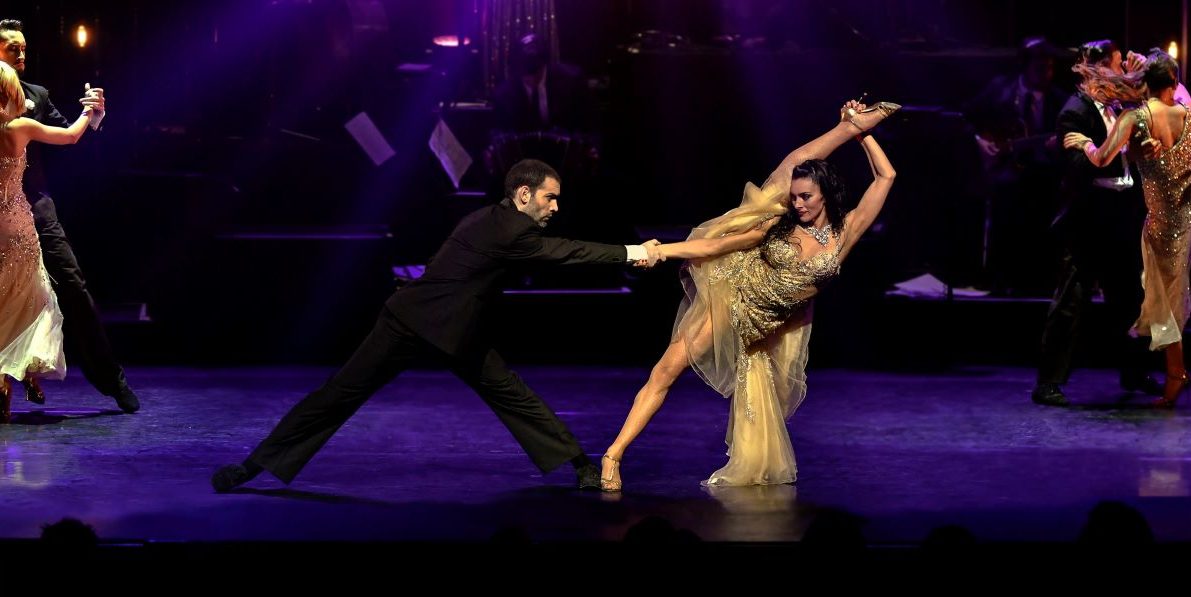I was fortunate enough to review ‘Immortal Tango’ at the Peacock back in 2016, and here the same team present another superlative show that slides past in a brief shimmer of an Argentine night despite the generous allocation of 26 separate numbers. Unlike its predecessor which focused on connecting the tango groove to audiences used to large-scale Hollywood songs, this show takes us to the heart of tango history by focusing entirely on the work of the leading exponent of ‘New Tango’, Astor Piazzolla.
This is the opposite of a conservative choice. Piazzolla self-consciously distanced himself from the traditional formulaic tango aesthetic of the 30s and 40s, and instead introduced elements of improvisation and jazz technique: his works are as a result complex, often lengthy, compositions – almost symphonic poems – that require many changes of mood and tempo. There is also more emphasis on individual storytelling through the bodies and temperaments of the dancers, rather than reliance on traditional back-street stereotypes of the hustler and the prostitute. These are taxing challenges for any choreographer, perhaps explaining why so often Piazzolla’s works appear on concert programmes rather than on the dance floor.
However, Germán Cornejo, assisted by his dance partner, Gisela Galeassi, are more than equal to the technical and emotional challenges presented. Across the span of the evening the five dance couples cover a huge spectrum of moods, tones, colours and styles even within the same tangos. Lyricism and melancholy shift into strutting swagger on the flick of a heel. Romantic intimacy is succeeded by swirling sequences that evoke crowded street scenes, and between each item there are careful transition moments in which the departing dancers elegantly and economically set the tonal segue for what comes next.
At the foundation of the evening lie two basic principles. Firstly, the choreography for each couple is designed around their own characters, personal dynamic and strengths, which removes at a stroke any danger of repetition or formation dancing. Some of the couples are more introspective, others more outwardly even brazenly passionate. Balletic moves dominate elsewhere playing to the previous experience and training of the principals. Gymnastic bravura and display represent the highpoints of other routines built around the special skill sets of the performers. What holds it all together is a shared desire to recreate the unique combination of defiance, introspection, yearning and resilience that goes with the poetic evocation of a sensual Buenos Aires night – the life of a ‘porteña’.
The second secret of success here is the supreme quality of the musicians playing and singing the compositions of Piazzolla. Placed at the back of the stage, often behind a scrim, but sometimes given independent foregrounding, this team of seven instrumentalists worked equally well as a crack team and as independent soloists, all getting their own moments of improvisation. Violin, piano, bandoneon, guitar, double bass, keyboards, and drums all got to shine, topped off with the soaring vocals of Antonela Chirillo and Jesús Hidalgo. My only cavil here is that without surtitles those of us lacking Spanish were not in the loop of the stories told through the songs. Credit should also go to the set, costume and lighting designers, whose worked contrived to generate the lushness and loucheness of the urban Latin street and cabaret.
With a new show, ‘Wild Tango’, also touring, which aims to extend the reach of tango into the pop repertory, Cornejo and his collaborators are demonstrating in a ground-breaking way that there are no real limits to the aesthetic and emotional reach of tango. By taking it out of its traditional boundaries they are liberating its dynamics and audience appeal in a way that should be of central interest to anyone interested in contemporary dance, however defined. This evening is not to be missed.

